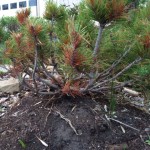 Whether it is planting summer annuals or costly trees the depth of your roots makes a significant difference to the plants health and longevity. As a general rule the roots should be completely buried with the plants or tree stem/trunk exposed. Quite simply the plant should be level with the ground. If plant roots are exposed they will desiccate rapidily causing growth retardation or death. Winter kill is often caused by this excessive drying of the roots. If the stem or trunk is buried, rot can occur. Branches growing directly in soil can cause disease problems.
Whether it is planting summer annuals or costly trees the depth of your roots makes a significant difference to the plants health and longevity. As a general rule the roots should be completely buried with the plants or tree stem/trunk exposed. Quite simply the plant should be level with the ground. If plant roots are exposed they will desiccate rapidily causing growth retardation or death. Winter kill is often caused by this excessive drying of the roots. If the stem or trunk is buried, rot can occur. Branches growing directly in soil can cause disease problems.
Certain plants parts are often mistaken as part of the root and covered with soil. Rhizomes (bulb like section) require full exposure to the sun or disease and insect infestations can occur. Rhizomes are familiar to most gardeners on iris species. The roots coming off the rhizomes need to be covered with the rhizome exposed. Bulbs or corms need to be completely buried usually at a depth of 3 to 4 times the height of the bulb. Bulbs are not a root but still require full coverage. Some bulbs take exception to this rule such as amaryllis, where the bulb needs full sun exposure, roots do still require full soil coverage.
Hybridized roses (includes most roses) have a large bulbous growth, where the graft meets the root stock. The conjunction of the graft should never be buried (it is often mistaken as part of the root) as this area will invite insects and other fungal or bacterial infections.
Finally if you are planning to use a tree well around your tree, ensure the tree is level with the lower soil in the well rather than the higher edges. Tree wells are better used in dry areas where water needs to be captured. In swampy low areas wells are not necessary, plants species with root systems that can tolerate excessive moisture are a better choice.